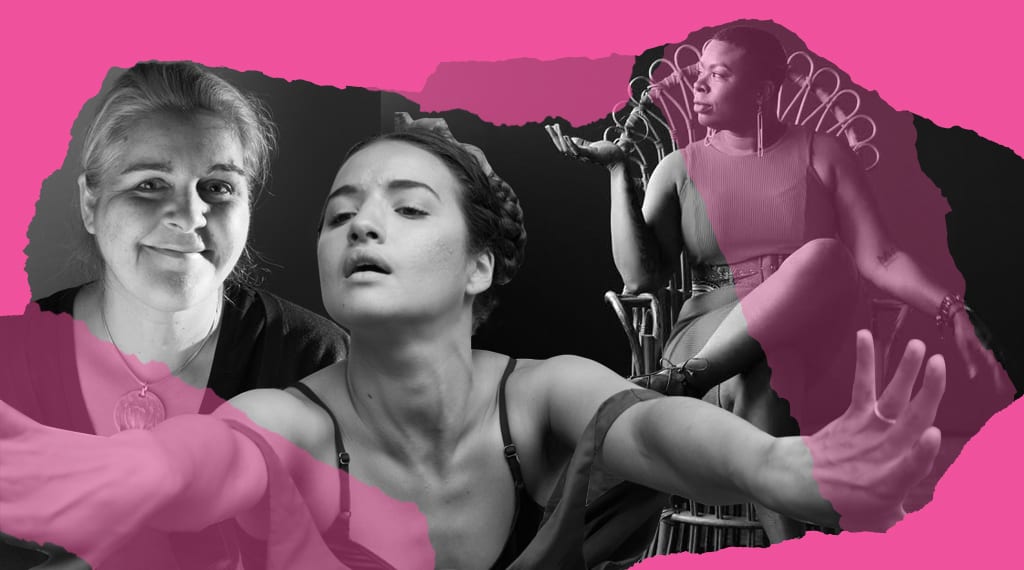In the downtown Toronto apartment she shared with her partner and elderly cat, Catherine Jones sat in her room looking at the online invitation she received to a dinner party to celebrate Bi Visibility Day. She paused and was shocked at the number of confirmed guests — four.
“Let’s organize something for next year,” she said to her partner after she reflected on the underwhelming response.
Now, Jones laughs as she recalls that day two years ago: not only did she organize something, she’s also founded one of the biggest bisexual arts festivals in Toronto.
Now in its second year, the Bi Arts Festival is dubbed as one of the world’s largest celebration of bisexual voices. The festival has grown into one of the biggest gatherings of artists who fall under the bisexual umbrella — individuals such as those who, according to Jones, identify as bisexual, bi-curious, pansexual and fluid.
But it’s more than just a celebration of arts: Jones says the festival is also a space where bisexual people tell their own stories, build communities and find healing.
“Authentic, true-to-life representation matters to the bi community because there are so many stereotypes from the straight community and the queer community about bisexuality,” Jones says as she explains the importance of the festival.
She says there is an assumption that bisexual people don’t exist or are confused. She adds some people see bisexual individuals as just experimenting and their sexuality is just a stepping stone on the way to becoming a gay man or lesbian.
“It’s strange because if you look at the stats, bisexuals make up the biggest piece of the [LGBT community] pie,” says Jones — and she’s not wrong.
Bisexual people make up the largest segment of the LGBT community, but as Jones claims, there’s still a lack of understanding and misrepresentation of this identity.
“So many people are trying to tell our stories and they’re getting it wrong all the time.”
Jones has noticed more open conversations about bisexuality in recent years, which she says may be a result of the surge of celebrities coming out as bisexual. She’s grateful for the greater discussion of bisexuality in the mainstream, something she never encountered.
As a teenager growing up in the late 1970s in a small town outside of Ottawa, Jones didn’t know what being gay or bisexual meant. It wasn’t discussed at home and there was no sex education at school to help her understand.
“Gay liberation never really reached that part of the country.”
Jones, who came out as bisexual 10 years ago, says it took her a long time to take comfort in embracing the bisexual label. Before that, she says she identified as queer because it aligned more with her political views at the time.
“Since I was a teenager, I’ve always identified as some flavour of queer.”
When she moved to Toronto, she says she was exposed to a larger bisexual community and its history, and finally embraced bisexual identity.
With this understanding, Jones acknowledges that her festival is built from the work of other bisexual people through the years who have celebrated and started conversations about bisexual identity.
But instead of the usual one-off events dedicated to bisexuality, she says the festival aims to be an annual and ongoing celebration of the identity — sort of a continuation of the legacy of the smaller events in the past.
“In our festival, bi stories are centred,” says Jones. “Bisexuals are not an afterthought or a token as it can happen in some other queer festivals.”
Importance of spaces
“I knew, literally, zero bisexual people when I was growing up. It was something that I didn’t even consider as a serious option until I saw a call of submission to a bisexual visibility cabaret,” says Sofi Gudiño, artistic director and founder of Inamorata Dance Collective. She was 18 years old at the time, and the word resonated with her. “Oh, bisexual, yeah. That seems like what I am.”
Gudiño is a Latinx individual who is born and raised in Toronto. At the Bi Arts Festival this year, Inamorata will perform Taura, a collaborative dance duo, that celebrates her ancestral roots. She says Taura is more than just a dance and celebration of sexuality: it also serves as a performance where Latinx folks “see that there is community solidarity and representation.”
“I want them to be transported into a world where history and the future exist at the same time,” she says. “Where anything is possible.”
Gudiño says the Bi Arts Festival is unlike other events for bisexual people where bisexuality is represented just one day a year. She says this is because festivals, by nature, last longer and have the ability to reach more audience to share experiences and cultures.
In a report published by Statistics Canada in 2014, bisexual people are less likely to feel a sense of belonging in their community. Only 59 percent of bisexual individuals reported feeling a “somewhat strong” or “very strong” sense of belonging to their local community, compared to 75 percent of heterosexual people surveyed.
Gudiño says not having a word to identify with when you’re young can make you feel alienated, which was part of the reason she wanted to be a visible bisexual woman in order to help others in the community who are also struggling with their identity. She says people reach out to ask her about bisexuality and her journey.
Finding dedicated places to connect with the bisexual community has historically been difficult and is one of the reasons that Jones, the festival’s founder, says she created the event.
“Spaces were usually one-offs,” she says. “We’re not able to come together and make community spaces to learn, to organize, to feel connected, to see yourself reflected.”
This sentiment is echoed by Eris Eady, an Ohio-based artist and one of the performers in this year’s Bi Arts Festival. She says it’s important for bisexual people to create spaces to celebrate their sexuality.
“If we don’t create our spaces, we can’t expect [others] to create the spaces for us,” she says.
Representation and art as healing
In a report released by the United Nations in July, it states that bisexual people are more prone than gay and lesbian persons to experience violence. In the same report, it cites a survey that found out 61 percent of bisexual women and 37 percent of bisexual men reported having experienced rape, physical violence and stalking by an intimate partner.
Data on the experiences of bisexual people can be disheartening; in fact, in a 2014 survey by Statistics Canada, bisexual women are four times more likely to be victims of a violent incident and seven times more likely to experience sexual assault than their heterosexual counterparts.
Eady, a sexual abuse survivor, says she continues to find healing through the arts. She says her one-woman show, Womannish, was cathartic to her and stretched her to intersect her artistic world with her advocacy world.
She says she can’t segregate individual parts of her identity — her sexuality, race, experiences and privileges — because these factors make her whole.
“I think that it’s important that people know that Black bisexual women exist,” she says. “I can’t see one part without seeing all of the parts because they’re all meaningful.”
Bisexual visibility matters
After the festival last year, founder Catherine Jones says she cried because of the interest and excitement from the community.
“Seeing yourself in someone’s story and being able to tell your own story is really important to bi people because so many people are trying to tell our stories and they’re getting it wrong all the time,” she says.
For Eady, spaces like Bi Arts Festival are an opportunity for bisexual people to showcase their experiences, talents and gifts.
“Gay people have a lot of power and influence, especially in the States where gay culture is extremely white,” she says. “Bisexual folks, we’re from all walks of life. We’re so much more diverse and we’re so much quieter about who we are. So, taking these opportunities to be more visible is audacious.”
“That audaciousness allows us to be free.”


 Why you can trust Xtra
Why you can trust Xtra


